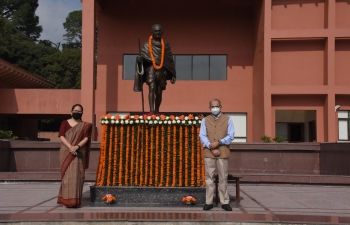Press Release
Government of India gifts 41 ambulances and 6 school buses to government and not-for profit organizations in 30 districts of Nepal
On the occasion of 151st Gandhi Jayanti, H.E. Vinay Mohan Kwatra, Ambassador of India to Nepal paid tribute to Mahatma Gandhi by placing flower at his statue situated in the Embassy premises.
2. The Embassy, continuing the tradition of gifting of ambulances and school buses, handed over forty one ambulances and six school buses to various governmental and non-governmental, not for profit organizations working in the field of health and education. These organizations are spread across 30 districts of Nepal, including remote districts. The Embassy has long-standing tradition of gifting ambulances and school buses to government and not for profit institutions every year to support grassroots medical access.
3. Since 1994, the Embassy of India has gifted nearly 823 ambulances, including those gifted today. For the first time, the Embassy has this year gifted three different categories of ambulances, Advance Life Support category, Basic Life Support and Common Life Support ambulances. All three categories are built as per the guidelines of Government of Nepal.
4. The Advance Life Support category ambulances include equipment such as travelling ventilator, ECG and Oxygen monitor, automated external defibrillator, nebulizer set, BP apparatus, stethoscope, Ambu bag, various tubes and catheters, wheel chair and stretcher, radio communication equipment and 4G mobile device, etc. The Basic Life Support ambulances have all these items, except for travelling ventilator. The Common Life Support ambulances are 4 Wheel Drive vehicles and best suited for hilly and mountainous terrains.
5. The Embassy has, so far, gifted 160 school buses across Nepal, including the six gifted today to educational institutions located in six districts of Nepal.
6. Today’s gifting of ambulances and school buses is part of Government of India continued support for the efforts of Nepal to strengthen health services, particularly emergency medical services and also facilitates easy physical access of students to their places of learning.

